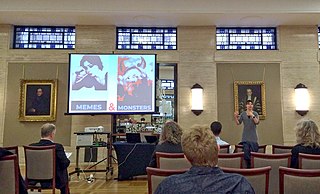Related Research Articles

Vilayanur Subramanian Ramachandran is an Indian-American neuroscientist. He is known for his wide-ranging experiments and theories in behavioral neurology, including the invention of the mirror box. Ramachandran is a distinguished professor in UCSD's Department of Psychology, where he is the director of the Center for Brain and Cognition.

A number form is a mental map of numbers, which automatically and involuntarily appears whenever someone who experiences number-forms thinks of numbers. Numbers are mapped into distinct spatial locations and the mapping may be different across individuals. Number forms were first documented and named by Sir Francis Galton in his The Visions of Sane Persons. Later research has identified them as a type of synesthesia.
Synesthesia is a neurological condition in which two or more bodily senses are coupled. For example, in a form of synesthesia known as grapheme-color synesthesia, letters or numbers may be perceived as inherently colored. Historically, the most commonly described form of synesthesia has been between sound and vision, e.g. the hearing of colors in music.

Grapheme–color synesthesia or colored grapheme synesthesia is a form of synesthesia in which an individual's perception of numerals and letters is associated with the experience of colors. Like all forms of synesthesia, grapheme–color synesthesia is involuntary, consistent and memorable. Grapheme–color synesthesia is one of the most common forms of synesthesia and, because of the extensive knowledge of the visual system, one of the most studied.
Lexical–gustatory synesthesia is a rare form of synesthesia in which spoken and written language causes individuals to experience an automatic and highly consistent taste/smell. The taste is often experienced as a complex mixture of both temperature and texture. For example, in a particular synaesthete, JIW, the word jail would taste of cold, hard bacon. Synesthetic tastes are evoked by an inducer/concurrent complex. The inducer is the stimulus that activates the sensation and the taste experience is the concurrent.
The phrase synesthesia in art has historically referred to a wide variety of artists' experiments that have explored the co-operation of the senses in the genres of visual music, music visualization, audiovisual art, abstract film, and intermedia. The age-old artistic views on synesthesia have some overlap with the current neuroscientific view on neurological synesthesia, but also some major differences, e.g. in the contexts of investigations, types of synesthesia selected, and definitions. While in neuroscientific studies synesthesia is defined as the elicitation of perceptual experiences in the absence of the normal sensory stimulation, in the arts the concept of synaesthesia is more often defined as the simultaneous perception of two or more stimuli as one gestalt experience. The usage of the term synesthesia in art should, therefore, be differentiated from neurological synesthesia in scientific research. Synesthesia is by no means unique to artists or musicians. Only in the last decades have scientific methods become available to assess synesthesia in persons. For synesthesia in artists before that time one has to interpret (auto)biographical information. For instance, there has been debate on the neurological synesthesia of historical artists like Kandinsky and Scriabin. Additionally, Synesthetic art may refer to either art created by synesthetes or art created to elicit synesthetic experience in the general audience.
Synesthesia is a neurological condition in which two or more bodily senses are coupled. For example, in a form of synesthesia known as Grapheme → color synesthesia, letters or numbers may be perceived as inherently colored. In another, called number → form synesthesia, numbers are automatically and consistently associated with locations in space. In yet another form of synesthesia, called ordinal linguistic personification, either numbers, days of the week, or months of the year evoke personalities. In other forms of synesthesia, music and other sounds may be perceived as colored or having particular shapes. Recent research has begun to explore the neural basis of these experiences, drawing both on neuroscientific principles and on functional neuroimaging data.

Chromesthesia or sound-to-color synesthesia is a type of synesthesia in which sound involuntarily evokes an experience of color, shape, and movement. Individuals with sound-color synesthesia are consciously aware of their synesthetic color associations/perceptions in daily life. Synesthetes that perceive color while listening to music experience the colors in addition to the normal auditory sensations. The synesthetic color experience supplements, but does not obscure real, modality-specific perceptions. As with other forms of synesthesia, individuals with sound-color synesthesia perceive it spontaneously, without effort, and as their normal realm of experience. Chromesthesia can be induced by different auditory experiences, such as music, phonemes, speech, and/or everyday sounds.
Synesthesia is a neurologically based phenomenon in which stimulation of one sensory or cognitive pathway leads to automatic, involuntary experiences in a second sensory or cognitive pathway. There are many occurrences of synesthesia in books, television and film.
Exceptional memory is the ability to have accurate and detailed recall in a variety of ways, including hyperthymesia, eidetic memory, synesthesia, and emotional memory. Exceptional memory is also prevalent in those with savant syndrome and mnemonists.

Synesthesia or synaesthesia is a perceptual phenomenon in which stimulation of one sensory or cognitive pathway leads to involuntary experiences in a second sensory or cognitive pathway. For instance, people with synesthesia may experience colors when listening to music, see shapes when smelling certain scents, or perceive tastes when looking at words. People who report a lifelong history of such experiences are known as synesthetes. Awareness of synesthetic perceptions varies from person to person with the perception of synesthesia differing based on an individual's unique life experiences and the specific type of synesthesia that they have. In one common form of synesthesia, known as grapheme–color synesthesia or color–graphemic synesthesia, letters or numbers are perceived as inherently colored. In spatial-sequence, or number form synesthesia, numbers, months of the year, or days of the week elicit precise locations in space, or may appear as a three-dimensional map. Synesthetic associations can occur in any combination and any number of senses or cognitive pathways.

Ideasthesia is a neuropsychological phenomenon in which activations of concepts (inducers) evoke perception-like sensory experiences (concurrents). The name comes from the Ancient Greek ἰδέα and αἴσθησις, meaning 'sensing concepts' or 'sensing ideas'. The notion was introduced by neuroscientist Danko Nikolić as an alternative explanation for a set of phenomena traditionally covered by synesthesia.
Mirror-touch synesthesia is a rare condition which causes individuals to experience a similar sensation in the same part or opposite part of the body that another person feels. For example, if someone with this condition were to observe someone touching their cheek, they would feel the same sensation on their own cheek. Synesthesia, in general, is described as a condition in which a concept or sensation causes an individual to experience an additional sensation or concept. Synesthesia is usually a developmental condition; however, recent research has shown that mirror touch synesthesia can be acquired after sensory loss following amputation.
Emotional intelligence (EI) involves using cognitive and emotional abilities to function in interpersonal relationships, social groups as well as manage one's emotional states. It consists of abilities such as social cognition, empathy and also reasoning about the emotions of others.
Sex differences in cognition are widely studied in the current scientific literature. Biological and genetic differences in combination with environment and culture have resulted in the cognitive differences among males and females. Among biological factors, hormones such as testosterone and estrogen may play some role mediating these differences. Among differences of diverse mental and cognitive abilities, the largest or most well known are those relating to spatial abilities, social cognition and verbal skills and abilities.

Avishai Henik is an Israeli neurocognitive psychologist who works at Ben-Gurion University of the Negev (BGU). Henik studies voluntary and automatic (non-voluntary/reflexive) processes involved in cognitive operations. He characterizes automatic processes, and clarifies their importance, the relationship between automatic and voluntary processes, and their neural underpinnings. Most of his work involves research with human participants and in recent years, he has been working with Archer fish to examine evolutionary aspects of various cognitive functions.

Roi Cohen Kadosh is an Israeli-British cognitive neuroscientist notable for his work on numerical and mathematical cognition and learning and cognitive enhancement. He is a professor of Cognitive Neuroscience and the head of the School of Psychology at the University of Surrey.
The genetic mechanism of synesthesia has long been debated, with researchers previously claiming it was a single X-linked trait due to seemingly higher prevalence in women and no evidence of male-male transmission This is where the only synesthetic parent is male and the male child has synesthesia, meaning that the trait cannot be solely linked to the X chromosome.

Ophelia Deroy is professor of Philosophy of Mind at Ludwig Maximilian University of Munich and a member of the Graduate School in Systemic Neuroscience (GSN) in Munich. She is the former deputy director of the Institute of Philosophy at the University of London. She received the Prix de la Chancellerie des Universites de Paris in 2007.
References
- 1 2 Simner, J.; Hubbard, E. M. (2006). "Variants of synaesthesia interact in cognitive tasks: Evidence for implicit associations and late connectivity in cross-talk theories". Neuroscience. 143 (3): 805–814. doi:10.1016/j.neuroscience.2006.08.018. PMID 16996695. S2CID 18922608.
- 1 2 Flournoy, T. (1893). Des Phénomènes de Synopsie. Geneva and Paris: Alcan.
- 1 2 Calkins, M. W. (1893). "A Statistical Study of Pseudo-chromesthesia and of Mental-forms". American Journal of Psychology. 5 (4): 439–464. doi:10.2307/1411912. JSTOR 1411912.
- ↑ Cytowic, R. E. (2002). Synesthesia: A Union of the Senses, 2nd ed. Cambridge, MA: MIT Press. ISBN 0-262-03296-1.
- 1 2 Simner, J.; Holenstein, E. (2007). "Ordinal linguistic personification as a variant of synesthesia". Journal of Cognitive Neuroscience. 19 (4): 694–703. doi:10.1162/jocn.2007.19.4.694. PMID 17381259. S2CID 6838388.
- ↑ Sagiv, N.; Amin, M.; Olu-Lafe, O.; Ward, J. (2005). "Beyond Colour: Further Varieties of Synaesthetic Experience" (PDF). 14th European Society for Cognitive Psychology Meeting, Aug 31 - Sep 3, Leiden, the Netherlands.
- ↑ Simner, J.; Rehme, M.K.; Carmichael, D.A.; Bastin, M.E.; Sprooten, E.; McIntosh, A.M.; Lawrie, S.M.; Zedler, M. (October 2016). "Social responsiveness to inanimate entities: Altered white matter in a 'social synaesthesia'" (PDF). Neuropsychologia. 91: 282–289. doi:10.1016/j.neuropsychologia.2016.08.020. PMID 27553270. S2CID 7521743.
- ↑ Matsuda, Eiko; Okazaki, Yoshihiro; Asano, Michiko; Yokosawa (2018). "Developmental Changes in Number Personification by Elementary School Children". Frontiers in Psychology. 9: 2214. doi: 10.3389/fpsyg.2018.02214 . PMC 6249874 . PMID 30498466.
- ↑ Rucker, R. (1995). Infinity and the Mind. Princeton University Press. ISBN 978-0-691-00172-2.
- ↑ Nemerov, Howard. "A Little Girl Tugs at the Tablecloth". Library of Congress, Washington, D.C. 20540 USA.
- ↑ Heil, Emily (16 September 2014). "D.C. 'Jeopardy!' contestant's riveting take on Alex Trebek's mustache". The Washington Post. Retrieved 1 July 2016.